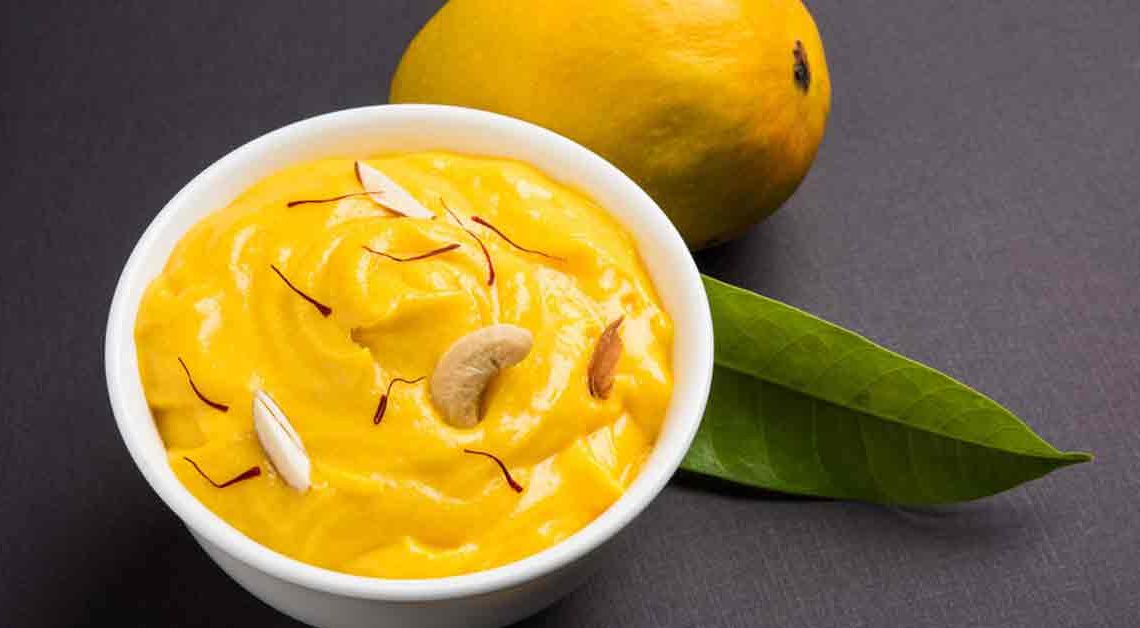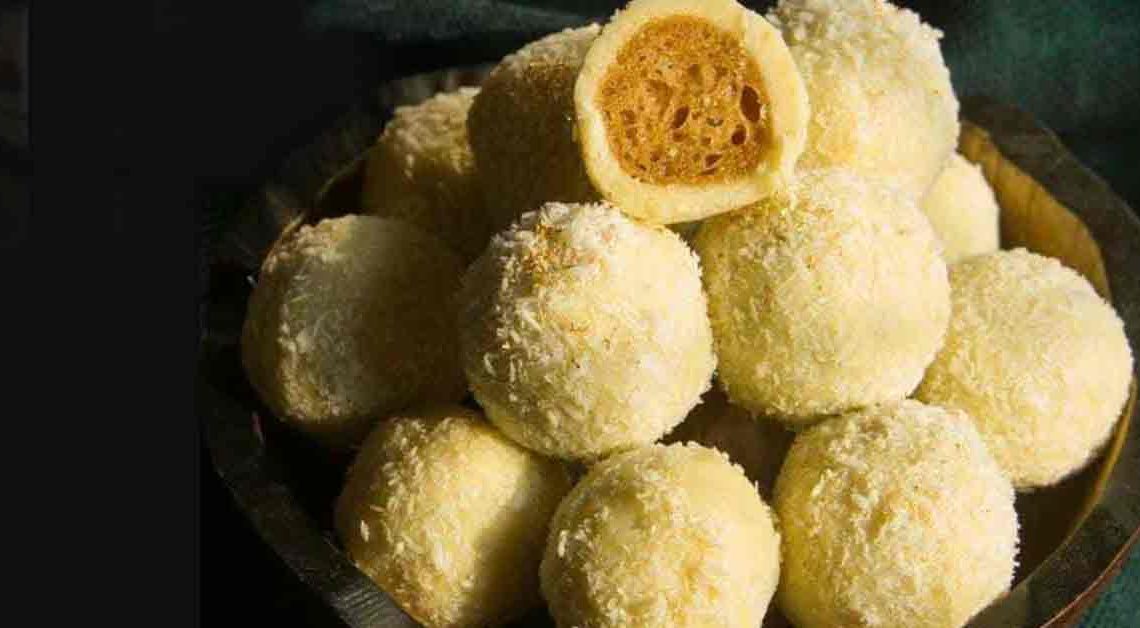Tropical Temptations: Mango Shrikhand Variations

Welcome to Mithainama, a delightful journey into the vibrant world of Mango Shrikhand! If there’s one dessert that encapsulates the essence of summer in a bowl, it’s this creamy, luscious Indian delicacy. Imagine ripe, juicy mangoes blended into velvety smoothness, harmonizing with the richness of strained yogurt and a sprinkle of aromatic spices. Each spoonful of Mango Shrikhand embodies a symphony of flavors, a perfect balance of sweetness and tanginess that dances on your taste buds.
Originating from the heart of Indian cuisine, Shrikhand holds a special place in traditional festivities and celebrations. And when infused with the tropical goodness of mangoes, it reaches new heights of culinary bliss. But this isn’t just about recipes; it’s a celebration of creativity and exploration. We’re here to unlock the secrets, share versatile adaptations, and provide tips to elevate your Mango Shrikhand experience.
Get ready to indulge in the irresistible allure of Amrakhand that’s sure to leave you craving more!
Origin of Mango Shrikhand
Mango Shrikhand, a popular dessert in Indian cuisine, has its roots deeply embedded in the culinary heritage of the Western states of India, particularly Gujarat and Maharashtra. Shrikhand, the base of this delectable treat, traces its origins to ancient times.
Shrikhand is traditionally made by straining thick yogurt or hung curd to remove excess whey, resulting in a creamy, thickened consistency. This strained yogurt is then sweetened with sugar or jaggery and flavored with aromatic spices such as saffron, cardamom, or nutmeg.
The evolution is a delightful addition to this classic recipe. The seasonal abundance of ripe, juicy mangoes in India inspired the infusion of this tropical fruit into the traditional Shrikhand, creating a delightful variation known as Aamrakhand. The addition of fresh mango pulp adds a vibrant hue, a burst of fruity sweetness, and a hint of tanginess to the rich and creamy Shrikhand.
History of Mango Shrikhand
The history in some regions, intertwines with the rich tapestry of Indian culinary traditions and the cultural significance of mangoes in the country.
Shrikhand itself has ancient roots in Indian cuisine, with its origins in the regions of Maharashtra and Gujarat. This traditional dessert involves straining hung curd or yogurt to achieve a thick, creamy consistency. The strained yogurt is then sweetened with sugar or jaggery and flavored with spices like saffron, cardamom, or nutmeg.
The evolution is a testament to the fusion of seasonal produce and traditional recipes. Mangoes, hailed as the “king of fruits” in India, have been revered for centuries. With the arrival of mango season, the idea of incorporating this beloved fruit into Shrikhand emerged. The addition of ripe mango pulp to the creamy base not only lent a vibrant yellow-orange hue but also imparted a delightful sweetness and tanginess, enhancing the overall flavor profile of the dessert.
Cultural Significance
Mango Shrikhand holds cultural significance within the realm of Indian cuisine and festivities, reflecting several aspects of cultural heritage and culinary traditions.
Festive Celebrations: In Indian culture, festivals and celebratory occasions often feature an array of traditional dishes. Amrakhand, with its rich, creamy texture and the infusion of seasonal mangoes, has become an integral part of various festivals and special events. It’s commonly prepared and shared during auspicious occasions like weddings, religious ceremonies, and festivals like Diwali, Holi, and Raksha Bandhan.
Seasonal Connection: Mangoes hold a revered status in India, not just for their taste but also for their symbolism. The arrival of mango season signifies the onset of summer, and becomes a way to celebrate this seasonal abundance. Incorporating mangoes into Shrikhand showcases the culinary adaptation to utilize seasonal produce and highlights the cultural appreciation for this revered fruit.
Taste of Tradition: Amrakhand, while a fusion dessert, encapsulates the essence of traditional flavors and techniques. It blends the time-honored process of making Shrikhand with the seasonal delight of mangoes, creating a dish that bridges the gap between nostalgia and innovation.
Where is Mango Shrikhand Famous?
Mango Shrikhand is particularly famous and beloved in various regions across India, especially in areas where mangoes are widely cultivated and consumed. Some of the regions where Mango Shrikhand holds significant popularity include:
Maharashtra: As the birthplace of Shrikhand, Maharashtra has a deep-rooted affection for this dessert. The addition of mangoes to Shrikhand to create amrakhand has garnered immense popularity in this state. Pune, Mumbai, and other cities in Maharashtra are known for their love for Amrakhand, especially during the summer season.
Gujarat: Another western Indian state, Gujarat, cherishes Amrakhand as a delectable treat. The Gujarati cuisine features a variety of flavorful dishes, and is a favorite during festivals, weddings, and celebratory occasions.
Southern States: While originating in western India, Mango Shrikhand’s popularity has spread to other regions, including southern states like Karnataka and Andhra Pradesh, where it is appreciated as a delightful dessert during mango season.
Interesting Facts and Trivia
Certainly! Here are some fascinating facts and trivia related to Mango Shrikhand:
- Shrikhand, the base of Mango Shrikhand, finds its mention in ancient Indian texts, including the Sanskrit scripture “Amarkosh,” dating back to several centuries. It has been a part of Indian cuisine for a long time.
- It combines the flavors of two beloved elements of Indian cuisine – the creamy richness of Shrikhand and the tropical sweetness of ripe mangoes, creating a delectable fusion dessert.
- It is a seasonal delight, typically enjoyed during the summer months when mangoes are at their peak. Its popularity surges during this time, offering a refreshing and indulgent treat to combat the heat.
- While Alphonso mangoes are commonly used due to their superior taste and texture, various regional mango varieties across India contribute to diverse flavors and nuances when incorporated into this dessert.
- Amrakhand, made from yogurt and mangoes, offers nutritional benefits. Yogurt provides probiotics that aid digestion, while mangoes contribute vitamins, antioxidants, and dietary fiber.
Did You Know?
Did you know? Consuming Mango Shrikhand not only delights your taste buds but also offers nutritional benefits. This delectable dessert combines the goodness of ripe mangoes and probiotic-rich yogurt, providing:
- Mangoes are abundant in vitamins A, C, and E, supporting skin health, immunity, and vision. Combined with yogurt, it offers a powerful dose of essential nutrients.
- Yogurt, a primary ingredient in Shrikhand, contains probiotics that promote a healthy gut flora, aiding digestion and potentially easing gastrointestinal discomfort.
- Mangoes are packed with antioxidants like beta-carotene and vitamin C, which help combat oxidative stress, fight inflammation, and protect cells from damage.
- The probiotics in yogurt may enhance nutrient absorption, allowing your body to better utilize the vitamins and minerals present in both mangoes and yogurt.
- Mangoes contribute hydration and dietary fiber, aiding in digestion, regulating bowel movements, and supporting overall gut health.







